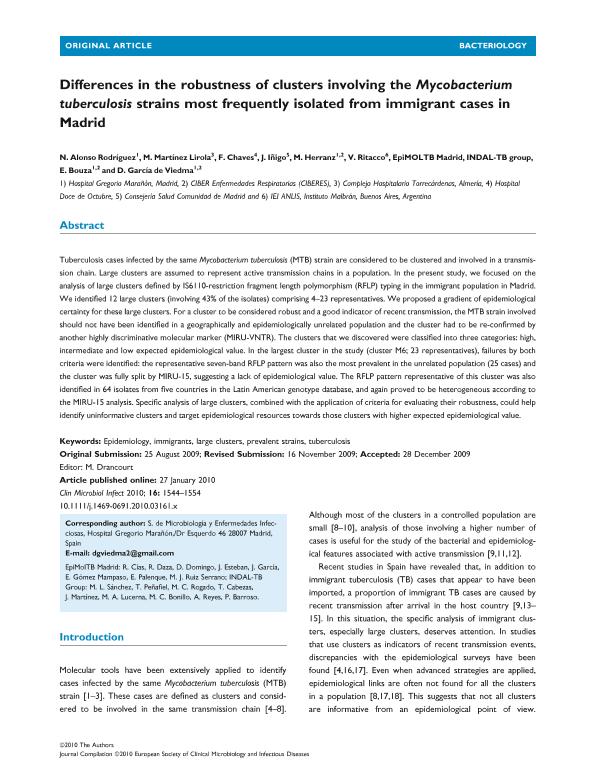Mostrar el registro sencillo del ítem
dc.contributor.author
Alonso Rodríguez, N.
dc.contributor.author
Martínez Lirola, M.
dc.contributor.author
Chaves, F.
dc.contributor.author
Iñigo, J.
dc.contributor.author
Herranz, M.
dc.contributor.author
Ritacco, Gloria Viviana

dc.contributor.author
Bouza, E.
dc.contributor.author
García de Viedma, D.
dc.date.available
2023-02-03T12:53:59Z
dc.date.issued
2010-10
dc.identifier.citation
Alonso Rodríguez, N.; Martínez Lirola, M.; Chaves, F.; Iñigo, J.; Herranz, M.; et al.; Differences in the robustness of clusters involving the Mycobacterium tuberculosis strains most frequently isolated from immigrant cases in Madrid; Elsevier; Clinical Microbiology And Infection; 16; 10; 10-2010; 1544-1554
dc.identifier.issn
1198-743X
dc.identifier.uri
http://hdl.handle.net/11336/186737
dc.description.abstract
Tuberculosis cases infected by the same Mycobacterium tuberculosis (MTB) strain are considered to be clustered and involved in a transmission chain. Large clusters are assumed to represent active transmission chains in a population. In the present study, we focused on the analysis of large clusters defined by IS6110-restriction fragment length polymorphism (RFLP) typing in the immigrant population in Madrid. We identified 12 large clusters (involving 43% of the isolates) comprising 4-23 representatives. We proposed a gradient of epidemiological certainty for these large clusters. For a cluster to be considered robust and a good indicator of recent transmission, the MTB strain involved should not have been identified in a geographically and epidemiologically unrelated population and the cluster had to be re-confirmed by another highly discriminative molecular marker (MIRU-VNTR). The clusters that we discovered were classified into three categories: high, intermediate and low expected epidemiological value. In the largest cluster in the study (cluster M6; 23 representatives), failures by both criteria were identified: the representative seven-band RFLP pattern was also the most prevalent in the unrelated population (25 cases) and the cluster was fully split by MIRU-15, suggesting a lack of epidemiological value. The RFLP pattern representative of this cluster was also identified in 64 isolates from five countries in the Latin American genotype database, and again proved to be heterogeneous according to the MIRU-15 analysis. Specific analysis of large clusters, combined with the application of criteria for evaluating their robustness, could help identify uninformative clusters and target epidemiological resources towards those clusters with higher expected epidemiological value.
dc.format
application/pdf
dc.language.iso
eng
dc.publisher
Elsevier

dc.rights
info:eu-repo/semantics/openAccess
dc.rights.uri
https://creativecommons.org/licenses/by-nc-sa/2.5/ar/
dc.subject
EPIDEMIOLOGY
dc.subject
IMMIGRANTS
dc.subject
LARGE CLUSTERS
dc.subject
PREVALENT STRAINS
dc.subject
TUBERCULOSIS
dc.subject.classification
Enfermedades Infecciosas

dc.subject.classification
Ciencias de la Salud

dc.subject.classification
CIENCIAS MÉDICAS Y DE LA SALUD

dc.subject.classification
Biología Celular, Microbiología

dc.subject.classification
Ciencias Biológicas

dc.subject.classification
CIENCIAS NATURALES Y EXACTAS

dc.title
Differences in the robustness of clusters involving the Mycobacterium tuberculosis strains most frequently isolated from immigrant cases in Madrid
dc.type
info:eu-repo/semantics/article
dc.type
info:ar-repo/semantics/artículo
dc.type
info:eu-repo/semantics/publishedVersion
dc.date.updated
2023-02-02T12:49:15Z
dc.journal.volume
16
dc.journal.number
10
dc.journal.pagination
1544-1554
dc.journal.pais
Países Bajos

dc.description.fil
Fil: Alonso Rodríguez, N.. Hospital General Universitario Gregorio Marañón (hosp Gral Univ G. Marañón); España
dc.description.fil
Fil: Martínez Lirola, M.. No especifíca;
dc.description.fil
Fil: Chaves, F.. Consejo Superior de Investigaciones Científicas; España
dc.description.fil
Fil: Iñigo, J.. No especifíca;
dc.description.fil
Fil: Herranz, M.. No especifíca;
dc.description.fil
Fil: Ritacco, Gloria Viviana. Dirección Nacional de Institutos de Investigación. Administración Nacional de Laboratorios e Institutos de Salud. Instituto Nacional de Enfermedades Infecciosas; Argentina. Consejo Nacional de Investigaciones Científicas y Técnicas; Argentina
dc.description.fil
Fil: Bouza, E.. Hospital General Universitario Gregorio Marañón (hosp Gral Univ G. Marañón); España
dc.description.fil
Fil: García de Viedma, D.. Hospital General Universitario Gregorio Marañón (hosp Gral Univ G. Marañón); España
dc.journal.title
Clinical Microbiology And Infection

dc.relation.alternativeid
info:eu-repo/semantics/altIdentifier/url/https://www.clinicalmicrobiologyandinfection.com/article/S1198-743X(14)60539-5/fulltext
dc.relation.alternativeid
info:eu-repo/semantics/altIdentifier/doi/http://dx.doi.org/10.1111/j.1469-0691.2010.03161.x
Archivos asociados
